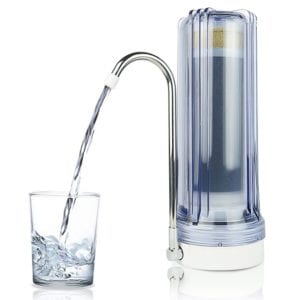 Water is life. It doesn’t only consist of 70 percent of our planet but it is also the crucial element in our living. Nowadays probably everyone knows how important it is to drink water. But of course, the water that you consume and use daily should be filtered and harmless for your health.
Water is life. It doesn’t only consist of 70 percent of our planet but it is also the crucial element in our living. Nowadays probably everyone knows how important it is to drink water. But of course, the water that you consume and use daily should be filtered and harmless for your health.
It is not the easiest tasks especially when you live in a megapolis where the sanitary standards of water are relatively lower.
Luckily, modern technologies allow us to enjoy the mountain-like fresh water even when you collected it from your tap. Besides, you can make sparkling water by yourself and enjoy high-quality water without going to the shop.
If you want to get the best water every day you should learn more about water filters and how they work. In this article, you will find out which one’s are the most technological and effective and will expand your knowledge about water filters in general.
1. Activated Carbon Filters
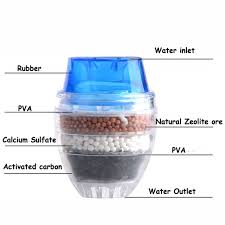 This is one of the most widespread types of filters and the most effective ones. They are also known as carbon filters or pre-filters. They are generally responsible for removing larger particles like sediment and silt from your water.
This is one of the most widespread types of filters and the most effective ones. They are also known as carbon filters or pre-filters. They are generally responsible for removing larger particles like sediment and silt from your water.
Activated Carbon Filters clean the water by attracting and absorbing the particles of those dangerous elements until there are none of those in the liquid that comes out of your faucet. It has the form of carbon blocks and usually has a pore size of between 0.5 to 10 micron.
Another distinctive feature of this filter is that in the end it makes the water taste and smell much better than other filters. This is because it reduces the amount of chlorine and other contaminants which can make your water smell badly or just darn right unpleasant to drink.
Moreover, the activated carbon filter adds useful minerals to the water.
However, this filter has one significant disadvantage. It doesn’t fully clean the water from other chemicals, like iron and nitrate (they are not attracted to the carbon) and another type of filters, such as reverse osmosis or green sand may be needed.
You may also like: How to choose safety kitchen degreasers
2. Reverse Osmosis
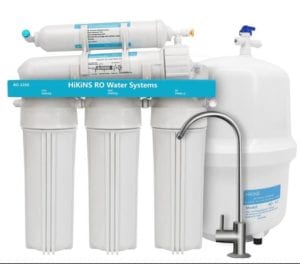 This filter is popular and widespread as well, mainly because it has the ability to remove all sorts of contaminants that can be a danger to your health. The ending quality of the water filtered this way is also crispy clean and deprived of any unwanted odors.
This filter is popular and widespread as well, mainly because it has the ability to remove all sorts of contaminants that can be a danger to your health. The ending quality of the water filtered this way is also crispy clean and deprived of any unwanted odors.
This filter may come in a variety of shapes. You can find out it is sold as a classic jug filter, where you renew the water each time before getting a new portion (useful for student dormitories), in a shape of special water filtering machines, and in the shape of the pipes which are getting fixed to the main water supply in your house, filtering the water and usually those filters demand a separate tap.
One of the biggest advantages of this filtration system is that it includes the replaceable parts which can be changed over time, prolonging the useful life of the whole filter. Moreover, they vary in price from expensive to super affordable so everyone will find something that is suitable for them.
However, even with this water filtration system, you need to remember that not all of them are effective. Yes, they might have gained huge popularity among households since they are known to “filter everything”. Unfortunately, this is not true; it’s a myth created by marketers in order to stimulate sales on Amazon.
In order to get a really effective Reverse Osmosis water filter, you should study this subject in advance. The thing is, some of these filters do clean everything, and others do nothing. In the case with this water filter, you always need to remember that at least once in a year you need to replace its prefilter part.
3. Alkaline filters/Water Ionizers
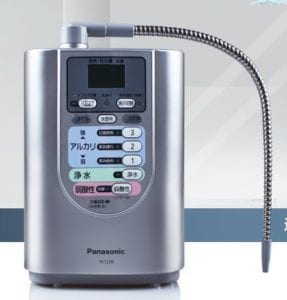 In early 1950, the first ionizer was developed in Japan, and the experiments were first conducted on plants and animals. It was in 1954 that the development pushed through and was achieved by a number of Japanese in Agricultural Universities.
In early 1950, the first ionizer was developed in Japan, and the experiments were first conducted on plants and animals. It was in 1954 that the development pushed through and was achieved by a number of Japanese in Agricultural Universities.
These types of liters clean the water by means of electrolysis. In this system, the water is passed over plates that are electrically charged, and it’s separated into two streams. One is alkaline and the other is acidic – actually, that’s why they have their name.
Ionized water is hydrogen-rich water because it contains quite a bit of molecular hydrogen, free-hydrogen to fight free radicals. The distinctive feature of this filter is that it brings the softer water to the ending user, which is much better for the skin. Usually, those filters look like digital machines with several buttons on them.
These filters were invented around 30 years ago and have proven to be one of the most reliable and long-living filters all around the world. The only drawback is that they are quite pricy. It is highly unlikely that you can buy a good Ionized filter for less than $2000.
But beware of possible negative effects of it. Adding salt is one way to achieve electrolysis as well as making the water more alkaline. The two electrodes will react to each other once the current is applied and will then produce hydrogen gas, hypochlorous acid, and sodium hydroxide. This mixture may react and can turn out into sodium hypochlorite.
The same element can be found in bleachers. Of course, it doesn’t mean that Ionized filter cleans the water in the same chemical way, but for some persons with high sensitivity to chemicals, it is better to show extra care.
By the way, are you sure your tableware materials are safe? Check this => What is the most reliable material for tableware
4. UV Filters
One of the latest water filter technologies that you have maybe not heard of yet. It is possible to guess by the name that here the ultraviolet radiation is used to treat water, thus killing all the dangerous bacteria in it. With enough energy, UV radiation at the 254-nm wavelength disrupts the DNA in pathogenic microorganisms so they cannot reproduce.
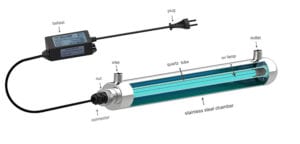 In fact, it destroys 99.99% of microorganisms in the water. Moreover, this filter is capable of working 24/7 keeping the water safe all the time. An interesting fact about this filter is this is one of only 4 methods approved for disinfection by the US Food & Drug Administration (FDA).
In fact, it destroys 99.99% of microorganisms in the water. Moreover, this filter is capable of working 24/7 keeping the water safe all the time. An interesting fact about this filter is this is one of only 4 methods approved for disinfection by the US Food & Drug Administration (FDA).
The feature that differs this filter from all the other ones is that it is an environmentally friendly way to clean the water, without the usage of various chemicals. This topic is quite popular right now so this type of filter has all the chances to win more attention in the near future.
This filter can be found in various forms. It can look like a box that you fix on the side of a jug with water. It also can look like a laser stick and you will need to “scan” the water manually in order to purify it. The price of these UV filters usually starts from $80 for the basic ones and can go up to $1000 for truly decent items.
5. Infrared Filters
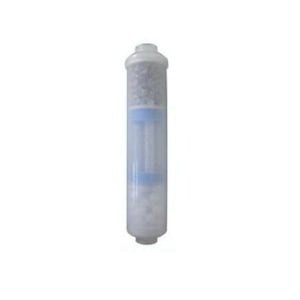 This technology is similar to alkaline filters in terms that it also helps to soften the water. On the other hand, the principle of the work of the Infrared filter is similar to the UV ones. So if you live in a hard water area infrared technology this type may be exactly what you are looking for.
This technology is similar to alkaline filters in terms that it also helps to soften the water. On the other hand, the principle of the work of the Infrared filter is similar to the UV ones. So if you live in a hard water area infrared technology this type may be exactly what you are looking for.
Much like alkaline filters, infrared uses heat and light to negatively charge the water, and give it a softer feel. And unlike UV filters, they don’t destroy all the biosystem in the water completely.
While ultraviolet rays are useful in destroying certain microorganisms present in water, infrared rays are said to have the opposite effect. They are said to improve the quality of water.
The distinctive feature of those filters is actually how they look. They are similar to the big capsules through which the water goes and gets filtered. By the way, if you cannot afford the ionized filter but still want to have softer water for usage then this is the perfect alternative.
Many models of infrared filters are made of high-end materials, such as ceramic and claim to activate water molecules in the human body along with improving our oxygen level and also promote metabolism.
6. Distillation
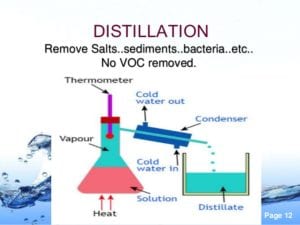 Well, this is probably one of the most complicated ways to filter the water, but also the most natural one. And if you ever see how the water gets filtered through the distillation, you will probably think that it looks rather how a scientific experiment. Water, filtered by distillation, is especially popular among dishwashers users.
Well, this is probably one of the most complicated ways to filter the water, but also the most natural one. And if you ever see how the water gets filtered through the distillation, you will probably think that it looks rather how a scientific experiment. Water, filtered by distillation, is especially popular among dishwashers users.
Safe drinking water is produced through a process wherein water undergoes boiling, evaporated and lets its vapor condensed and become distilled drinking water. This process eliminates unhealthy substances, organic and inorganic chemicals as well as heavy metals too same with reverse osmosis.
In other words, it kills all bacteria and pathogens that may be harmful to people. Of course, there are modern distillation water filters on the modern market and you can get a one for yourself, but be ready that they are not the cheapest ones. You can always filter the water this way yourself, but it is a very time and power-consuming process.
